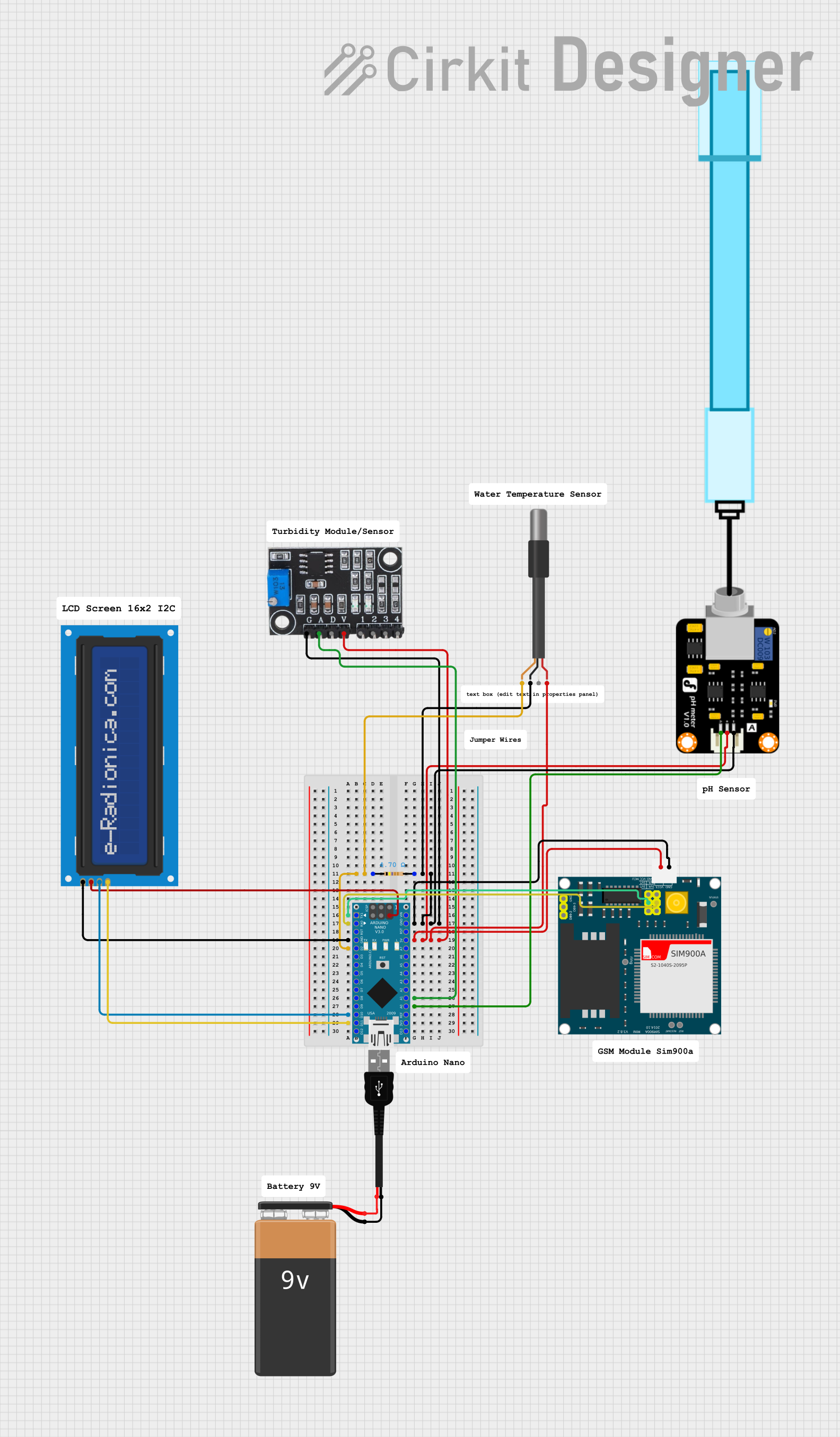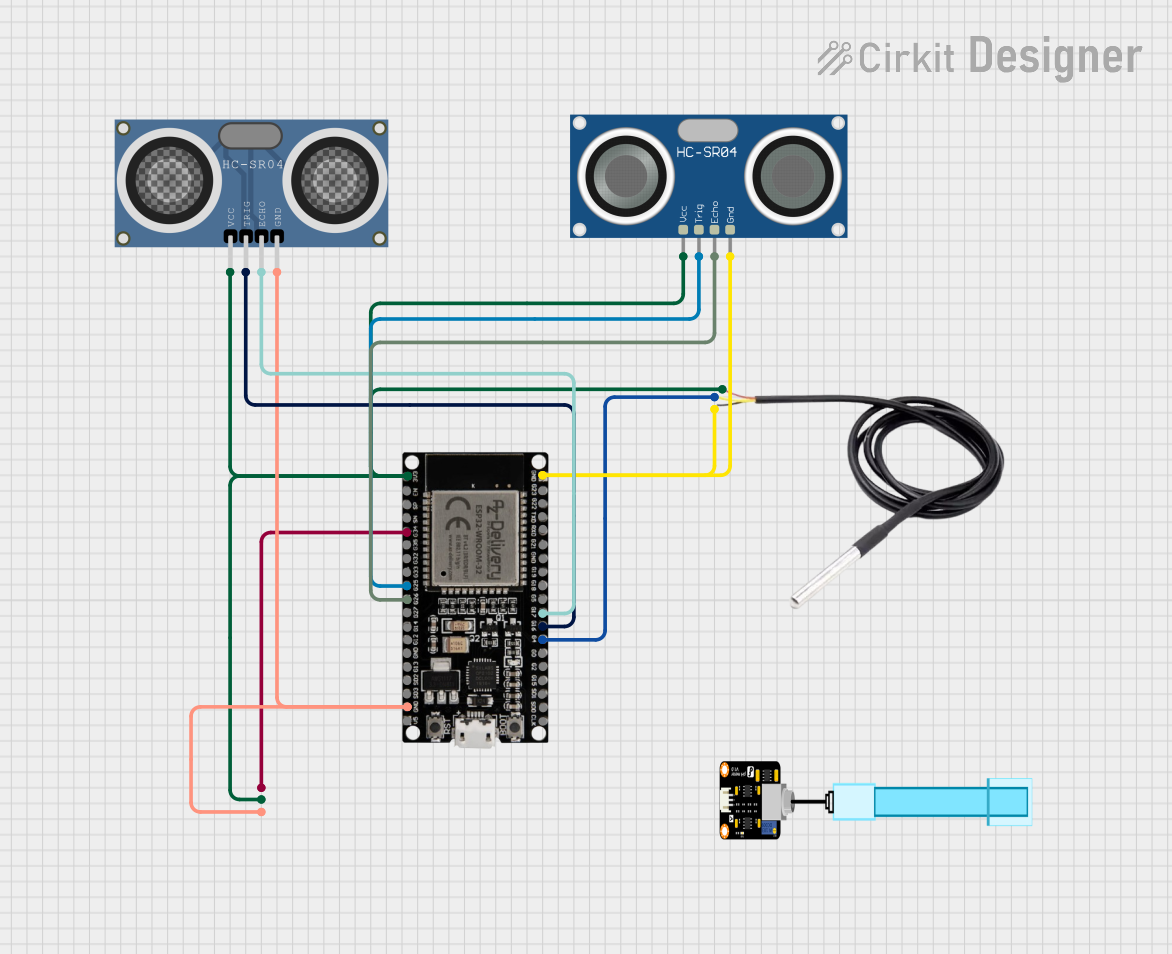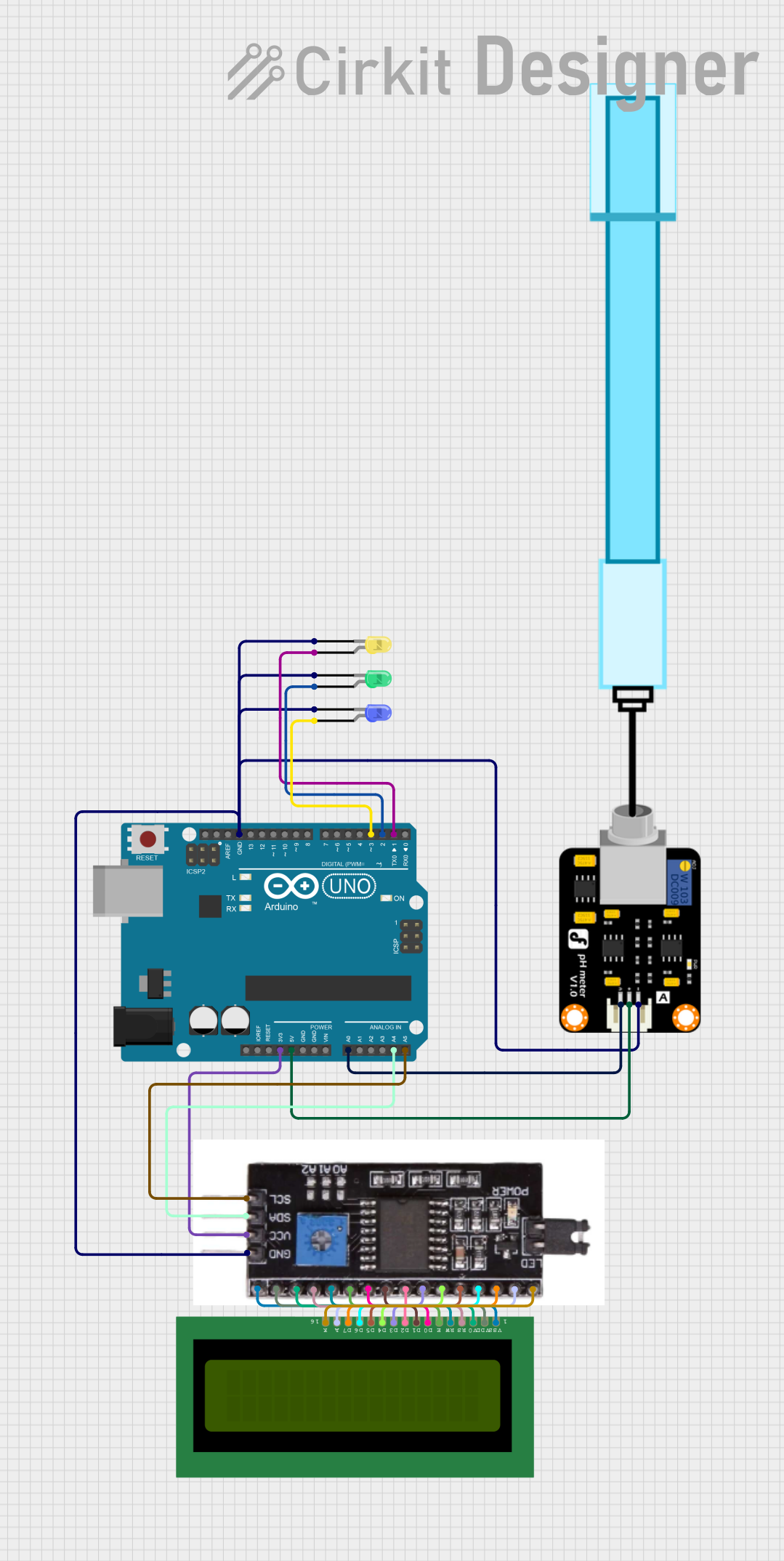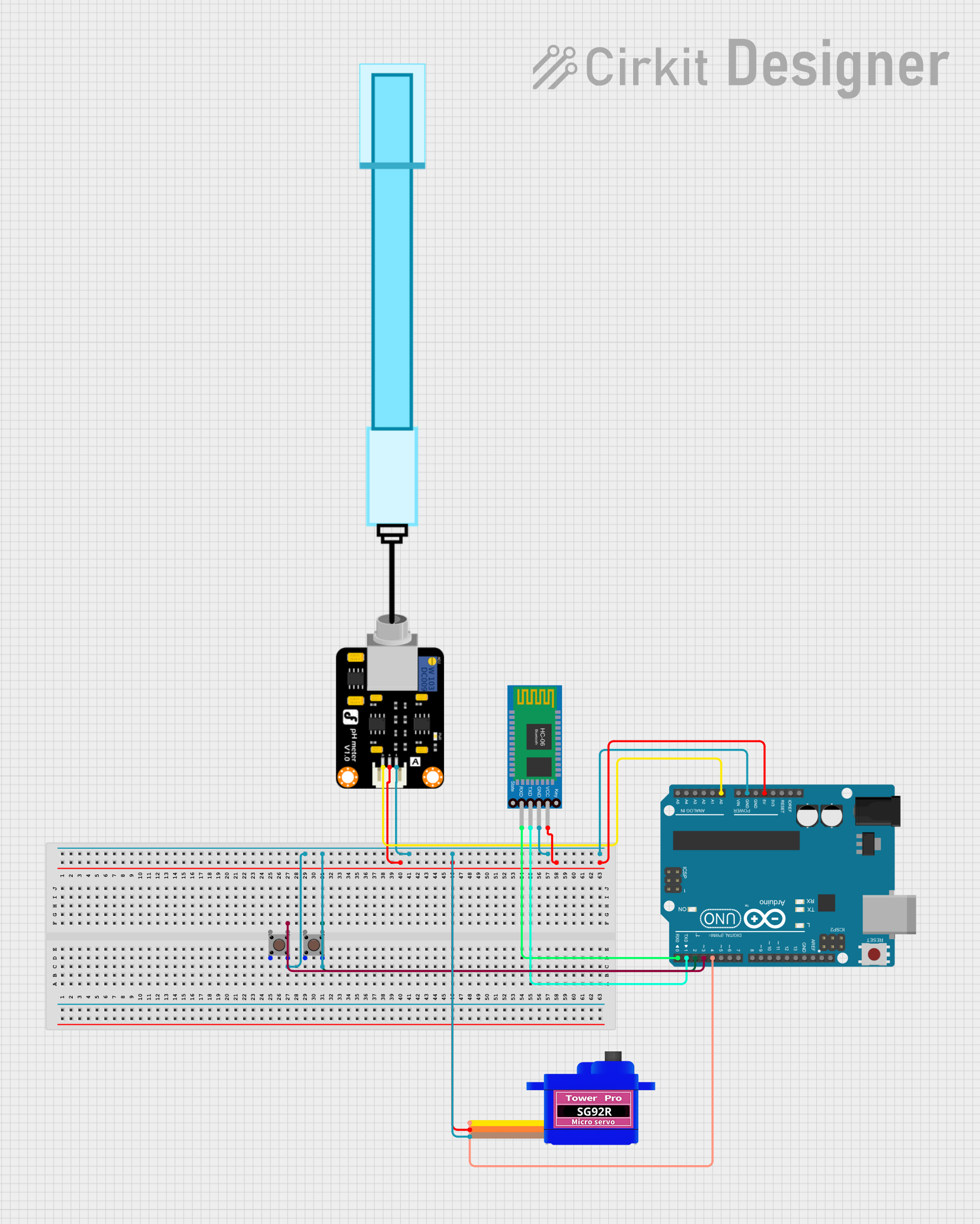
How to Use PH Sensor: Examples, Pinouts, and Specs

 Design with PH Sensor in Cirkit Designer
Design with PH Sensor in Cirkit DesignerIntroduction
A pH sensor is an electronic device used to measure the acidity or alkalinity of a solution. It provides a voltage output that corresponds to the pH level, typically ranging from 0 (highly acidic) to 14 (highly alkaline), with 7 being neutral. The sensor is widely used in various fields, including water quality monitoring, agriculture, food processing, and laboratory experiments.
Explore Projects Built with PH Sensor

 Open Project in Cirkit Designer
Open Project in Cirkit Designer
 Open Project in Cirkit Designer
Open Project in Cirkit Designer
 Open Project in Cirkit Designer
Open Project in Cirkit Designer
 Open Project in Cirkit Designer
Open Project in Cirkit DesignerExplore Projects Built with PH Sensor

 Open Project in Cirkit Designer
Open Project in Cirkit Designer
 Open Project in Cirkit Designer
Open Project in Cirkit Designer
 Open Project in Cirkit Designer
Open Project in Cirkit Designer
 Open Project in Cirkit Designer
Open Project in Cirkit DesignerCommon Applications and Use Cases
- Monitoring pH levels in aquariums and hydroponic systems
- Water treatment and quality control
- Soil pH measurement in agriculture
- Food and beverage production
- Laboratory experiments and chemical analysis
Technical Specifications
Below are the key technical details of a typical pH sensor module:
| Parameter | Value |
|---|---|
| Operating Voltage | 3.3V - 5V |
| Output Voltage Range | 0V - 3V (corresponding to pH 0-14) |
| pH Measurement Range | 0 - 14 |
| Accuracy | ±0.1 pH (at 25°C) |
| Temperature Range | 0°C - 60°C |
| Response Time | ≤ 1 second |
| Probe Type | Glass electrode |
| Calibration | Two-point (pH 4.0 and pH 7.0) |
Pin Configuration and Descriptions
The pH sensor module typically has the following pins:
| Pin Name | Description |
|---|---|
| VCC | Power supply input (3.3V - 5V) |
| GND | Ground connection |
| AO | Analog output pin, provides voltage proportional to the pH level |
| DO (optional) | Digital output pin, used for threshold-based pH detection (not always present) |
Usage Instructions
How to Use the pH Sensor in a Circuit
Connect the Sensor:
- Connect the
VCCpin to the 5V pin of your microcontroller (e.g., Arduino UNO). - Connect the
GNDpin to the ground (GND) of your microcontroller. - Connect the
AOpin to an analog input pin (e.g., A0) on the microcontroller.
- Connect the
Calibrate the Sensor:
- Immerse the pH probe in a standard buffer solution with a known pH value (e.g., pH 7.0).
- Adjust the potentiometer on the sensor module until the output voltage corresponds to the known pH value.
- Repeat the process with a second buffer solution (e.g., pH 4.0) for two-point calibration.
Measure pH:
- Place the pH probe in the solution to be measured.
- Read the analog voltage output from the
AOpin and convert it to a pH value using the formula provided in your sensor's datasheet.
Important Considerations and Best Practices
- Always rinse the pH probe with distilled water before and after use to prevent contamination.
- Store the pH probe in a storage solution or buffer solution to maintain accuracy and prolong its lifespan.
- Avoid exposing the probe to extreme temperatures or harsh chemicals that could damage the glass electrode.
- Perform regular calibration to ensure accurate readings, especially if the sensor is used frequently.
Example Code for Arduino UNO
Below is an example code snippet to read pH values using an Arduino UNO:
// Define the analog pin connected to the pH sensor
const int pH_Pin = A0;
// Define the voltage-to-pH conversion parameters
// Adjust these values based on your sensor's datasheet and calibration
const float voltageOffset = 0.0; // Offset voltage for calibration
const float pH_Scale = 3.0 / 14.0; // Voltage range divided by pH range
void setup() {
Serial.begin(9600); // Initialize serial communication
pinMode(pH_Pin, INPUT); // Set the pH pin as input
}
void loop() {
// Read the analog voltage from the pH sensor
int sensorValue = analogRead(pH_Pin);
float voltage = sensorValue * (5.0 / 1023.0); // Convert ADC value to voltage
// Calculate the pH value
float pH = (voltage - voltageOffset) / pH_Scale;
// Print the pH value to the Serial Monitor
Serial.print("pH Value: ");
Serial.println(pH);
delay(1000); // Wait for 1 second before the next reading
}
Troubleshooting and FAQs
Common Issues and Solutions
Inaccurate Readings:
- Cause: The sensor is not calibrated properly.
- Solution: Perform a two-point calibration using standard buffer solutions.
Fluctuating Output:
- Cause: Electrical noise or unstable power supply.
- Solution: Use a decoupling capacitor between
VCCandGNDto stabilize the power supply.
No Output or Constant Value:
- Cause: Faulty connections or damaged probe.
- Solution: Check all connections and ensure the probe is not physically damaged.
Slow Response Time:
- Cause: Dirty or clogged probe.
- Solution: Clean the probe with a soft brush and rinse with distilled water.
FAQs
Q: How often should I calibrate the pH sensor?
A: It is recommended to calibrate the sensor before each use or at least once a week for frequent usage.
Q: Can I use the pH sensor in high-temperature solutions?
A: Most pH sensors are rated for temperatures up to 60°C. Check your sensor's specifications and avoid exceeding the temperature limit.
Q: What should I do if the probe dries out?
A: Soak the probe in a storage solution or pH 4.0 buffer solution for several hours to rehydrate it.
Q: Can I use the pH sensor for continuous monitoring?
A: Yes, but ensure the probe is properly maintained and calibrated regularly to ensure accuracy over time.